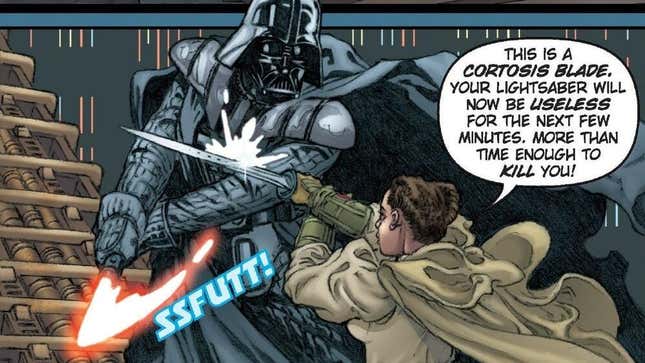With a swing of a wrist gauntlet, and the head-butt of a sinister helmet, The Acolyte’s mysterious dark Stranger carved a path into Star Wars history this week with a single, shocking move: strikes that sent the laser blades of his Jedi foes sputtering out of existence. But while we’ve seen lightsaber-resistant material in Star Wars plenty already, what could cause this strange effect? An infamous material from the Expanded Universe.
What Is Cortosis?
A very rare and very brittle material, cortosis was first introduced in 1998 novel I, Jedi by Michael Stackpole. On top of its rarity, cortosis was extremely difficult to mine due to its conductive properties. Like several other materials in the galaxy far, far away, it was capable of resistance to standard energy weapons like blasters—but unlike others, cortosis found a niche with the discovery that it could also conduct the energy of a lightsaber blade, shorting out the weapon for a period of up to several minutes.
Although cortosis featured heavily in the Expanded Universe as a premiere anti-Jedi material—although some interpretations of it treated it like any other energy-resistant metals—it did also make its way back into current continuity pretty early on. After first being canonized in the 2015 Rebels prequel novel A New Dawn, by John Jackson Miller, cortosis has made appearances in several comics, mainly Darth Vader and Aphra, but its most prominent appearance prior to its use in The Acolyte as the material the Stranger’s helmet is made out of was in Timothy Zahn’s Thrawn: Alliances in 2018.
There, Anakin Skywalker, Padmé Amidala, and the Chiss Expansionary Defense Force officer known as Mitth’raw’nuruodo—the future Grand Admiral Thrawn—discovered a cortosis mine on the planet Mokivj, which was being used to develop a range of cortosis-enhanced Super Battle Droids (as well as, at the behest of Darth Sidious, cortosis-enhanced Clone Trooper armor to be used during Order 66). The trio destroyed the mine, but at great cost to Mokivj itself, when Anakin failed to account for cortosis’ unique energy-redirection properties, sparking volcanic activity that ultimately radically transformed much of the world’s ecosystem.
How Does Cortosis Work?
In both the old Expanded Universe and current continuity, cortosis fibers had high energy absorption and conduction properties, making the directed energy of a blaster bolt that struck the material dissipate across the fibers with minimal damage. While this trait is common in other materials in the galaxy far, far away, cortosis’ extreme absorption and conduction is unique, to the point that striking it with an energy blade like a lightsaber’s would cause the energy field maintaining the blade to dissipate, causing a feedback loop that would temporarily shut down the lightsaber itself. Previous Star Wars material has been inconsistent in just how long a lightsaber is disabled by cortosis—in some instances, it’s only a stop-gap, and a de-activated lightsaber can be immediately re-activated; in others, the weapon is rendered inoperative for several minutes.
While The Acolyte provided our first on-screen look at cortosis in action, it also seemingly introduced a property it’s never had before. While dueling Jedi Master Sol, the Stranger implies that his cortosis mask also inhibits telepathy somehow, telling the Jedi that he refuses to take his mask off so Sol can’t read his thoughts. Whether that’s grandstanding on the Stranger’s part or an actual new property of cortosis itself, however, remains to be seen.
What Other Materials Resist Lightsabers?

Like we said, cortosis is far from the only material in Star Wars capable of blocking a lightsaber blade in either the Expanded Universe or current continuity. Of course, we have the Mandalorian iron, beskar, but there’s also phrik—the metal alloy used to construct electrostaffs. Other metals capable of resisting a lightsaber blade from both continuities include:
- Neuranium, which the statue Palpatine hid his lightsabers in was made of
- Songsteel, briefly canonized in the 2022 novel Shadow of the Sith as the material an amulet owned by Rey’s father, Dathan, was made out of
- Armorweave, a kevlar-esque material that could be fashioned into clothes and undergarments
The Expanded Universe also introduced Vonduun crab armor, the spiked gear worn by the footsoldiers of the Yuuzhan Vong—which was described as having a crystalline structure that made it capable of blocking blaster fire and lightsaber bolts—as well as Ultrachrome, an ancient metal with high superconductive properties used in crafting starship armor that appears in Star Wars: The Old Republic and is mentioned in the Mace Windu novel Shatterpoint.
Why Use Them Over Cortosis?

But if cortosis could both dissipate blaster fire and disable a lightsaber for a period of time, why was it so infrequently used compared to other materials? Well, like we said, in both the EU and the current canon cortosis is an extremely rare material. But even if you can find it, it’s very difficult to develop into a lightsaber-resistant material at scale. Cortosis required careful refining as it was also extremely brittle—making it difficult and often useless to craft whole weapons or suits of armor out of it, compared to something like beskar or the more common armorweave.
Small blades, or helmets and gauntlets like those used by the Stranger, were the preferred deployment of cortosis—individual pieces that could be used for the material’s specific properties alongside regular armor. However, cortosis could also be used in a smithing technique known as cortosis-weave, where a mesh of fibers of cortosis ore could be bonded to armor and weaponry made from other materials. While this would help grant enough energy conduction to block a lightsaber blade, cortosis’ unique ability to short the weapon out would be reliant on the amount of cortosis itself used in the weave—given its rarity and difficulty to use, more often cortosis-weave gear was only capable of resistance.
Want more io9 news? Check out when to expect the latest Marvel, Star Wars, and Star Trek releases, what’s next for the DC Universe on film and TV, and everything you need to know about the future of Doctor Who.
Trending Products

Cooler Master MasterBox Q300L Micro-ATX Tower with Magnetic Design Dust Filter, Transparent Acrylic Side Panel…

ASUS TUF Gaming GT301 ZAKU II Edition ATX mid-Tower Compact case with Tempered Glass Side Panel, Honeycomb Front Panel…

ASUS TUF Gaming GT501 Mid-Tower Computer Case for up to EATX Motherboards with USB 3.0 Front Panel Cases GT501/GRY/WITH…

be quiet! Pure Base 500DX Black, Mid Tower ATX case, ARGB, 3 pre-installed Pure Wings 2, BGW37, tempered glass window

ASUS ROG Strix Helios GX601 White Edition RGB Mid-Tower Computer Case for ATX/EATX Motherboards with tempered glass…










